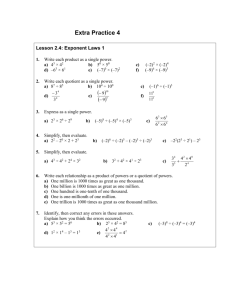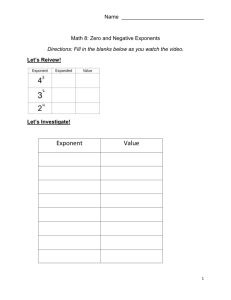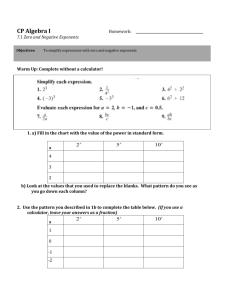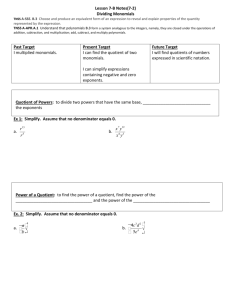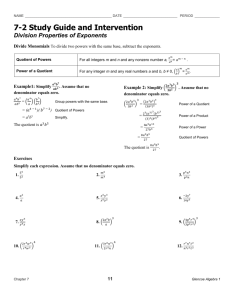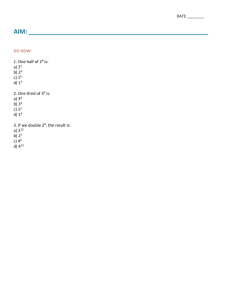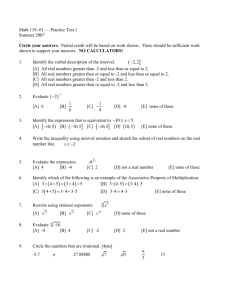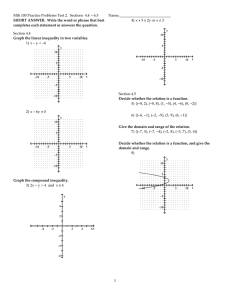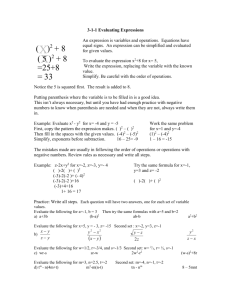expression assume
advertisement
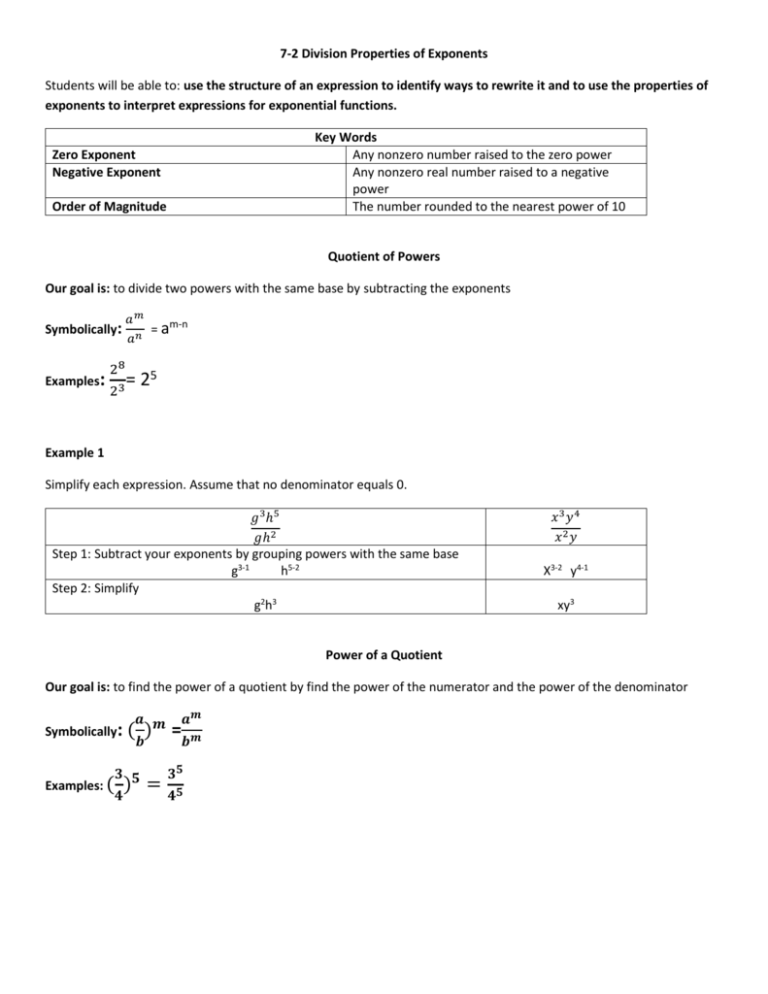
7-2 Division Properties of Exponents Students will be able to: use the structure of an expression to identify ways to rewrite it and to use the properties of exponents to interpret expressions for exponential functions. Key Words Any nonzero number raised to the zero power Any nonzero real number raised to a negative power The number rounded to the nearest power of 10 Zero Exponent Negative Exponent Order of Magnitude Quotient of Powers Our goal is: to divide two powers with the same base by subtracting the exponents Symbolically: 𝑎𝑚 𝑎𝑛 28 Examples: 3 = 2 = am-n 25 Example 1 Simplify each expression. Assume that no denominator equals 0. 𝑔 3 ℎ5 𝑔ℎ2 Step 1: Subtract your exponents by grouping powers with the same base g3-1 h5-2 Step 2: Simplify g2h3 𝑥3𝑦4 𝑥2𝑦 X3-2 y4-1 xy3 Power of a Quotient Our goal is: to find the power of a quotient by find the power of the numerator and the power of the denominator Symbolically: 𝒂 𝒂𝒎 𝒃 𝒃𝒎 ( )𝒎 = 𝟑 𝟓 Examples: ( ) 𝟒 = 𝟑𝟓 𝟒𝟓 Example 2 Simplify each expression. 3𝑥 4 3 ) 4 3𝑝3 2 ) 7 ( ( Step 1: The power goes to the coefficient and the variable 32 (𝑝3 )2 72 Step 2: Simplify using power of a product from yesterday’s lesson 9𝑝6 49 33 (𝑥 4 )3 43 27𝑥 12 64 Zero Exponent Property Our goal is: any nonzero number raised to the zero power is equal to 1 Symbols: (b)0 = 1 Example: (15)0 = 1 Negative Exponents Our goal is: for any nonzero number a and any integer n, 𝑎−𝑛 is the reciprocal of an, likewise the reciprocal of 𝑎−𝑛 is an Symbols: 𝑎−𝑛 = 1 𝑎𝑛 Example: 2−4 = 1 24 1 = 16 Example 3 Simplify each expression. Assume that no denominator equals zero. 𝒏−𝟓 𝒑𝟒 𝒓−𝟐 Step 1: Rewrite the expression with all positive exponents. 𝟏 𝒓𝟐 𝟒 ∗ 𝒑 ∗ 𝟏 𝒏𝟓 Step 2: Simplify each term 𝟏 𝒓𝟐 𝟒 ∗ 𝒑 ∗ 𝟏 𝒏𝟓 Step 3: Combine terms using multiplication 𝒑𝟒 𝒓𝟐 𝒏𝟓 𝟓𝒓−𝟑 𝒕𝟒 −𝟐𝟎𝒓𝟐 𝒕𝟕 𝒖−𝟓 𝟓 𝟏 𝒕𝟒 𝒖𝟓 ∗ 𝟐 ∗ ∗ −𝟐𝟎 𝒓 ∗ 𝒓𝟑 𝒕𝟕 𝟏 𝟐𝒂𝟐 𝒃𝟑 𝒄−𝟓 𝟏𝟎𝒂−𝟑 𝒃−𝟏 𝒄−𝟒 𝟐 𝒂𝟐 ∗ 𝒂𝟑 𝒃𝟑 ∗ 𝒃𝟏 𝒄𝟒 ∗ ∗ ∗ 𝟓 𝟏𝟎 𝟏 𝟏 𝒄 𝟏 𝟏 𝟏 𝒖𝟓 ∗ 𝟓∗ 𝟑∗ −𝟒 𝒓 𝒕 𝟏 𝟏 𝒂𝟓 𝒃𝟒 𝟏 ∗ ∗ ∗ 𝟓 𝟏 𝟏 𝒄 𝒖𝟓 −𝟒𝒓𝟓 𝒕𝟑 𝒂𝟓 𝒃𝟒 𝟓𝒄
